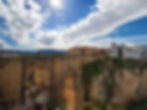


PETRA / JORDAN
PETRA ANCIENT SITE
JORDAN
Petra originally known to its inhabitants as Raqmu, is a historic and archaeological city in southern Jordan. It is adjacent to the mountain of Jabal Al-Madbah, in a basin surrounded by mountains forming the eastern flank of the Arabah valley running from the Dead Sea to the Gulf of Aqaba. The area around Petra has been inhabited from as early as 7000 BC, and the Nabataeans might have settled in what would become the capital city of their kingdom as early as the 4th century BC. Archaeological work has only discovered evidence of Nabataean presence dating back to the second century BC, by which time Petra had become their capital. The Nabataeans were nomadic Arabs who invested in Petra's proximity to the incense trade routes by establishing it as a major regional trading hub.

Click on the pic. to zoom in
The trading business gained the Nabataeans considerable revenue and Petra became the focus of their wealth. Unlike their enemies, the Nabataeans were accustomed to living in the barren deserts and were able to repel attacks by taking advantage of the area's mountainous terrain. They were particularly skillful in harvesting rainwater, agriculture and stone carving. Petra flourished in the 1st century AD, when its Al-Khazneh structure – believed to be the mausoleum of Nabataean king Aretas IV – was constructed, and its population peaked at an estimated 20,000 inhabitants.
Although the Nabataean kingdom became a client state of the Roman Empire in the first century BC, it was only in 106 AD that it lost its independence. Petra fell to the Romans, who annexed Nabataea and renamed it as Arabia Petraea. Petra's importance declined as sea trade routes emerged, and after an earthquake in 363 destroyed many structures. In the Byzantine era, several Christian churches were built, but the city continued to decline and, by the early Islamic era, it was abandoned except for a handful of nomads. It remained unknown to the western world until 1812, when Swiss traveller Johann Ludwig Burckhardt rediscovered it.
Access to the city is through a 1.2-kilometre-long gorge called the Siq, which leads directly to the Khazneh. Famous for its rock-cut architecture and water conduit system, Petra is also called the "Rose City" because of the colour of the stone from which it is carved

Click on the pic. to zoom in

Click on the pic. to zoom in
Petra is known primarily for its Hellenistic architecture. The facades of the tombs in Petra are commonly rendered in Hellenistic style, reflecting the number of diverse cultures which the Nabataens traded, all of which were in turn influenced by Greek culture. Most of these tombs contain small burials niches carved into the stone.
Perhaps the best example of the Hellenistic style is seen in the Treasury, which is 24 meters wide and 37 metersall and references the architecture of Alexandria.
Another prime example of Hellenistic architecture featured in Petra is its Monastery, which stands at 45 meters tall and 50 meters wide; this is Petra's largest monument and is similarly carved into the rock face. The facade of this again features a broken pediment, similar to the Treasury, as well as another central tholos.
A little farther from the Treasury, at the foot of the mountain called en-Nejr, is a massive theatre, positioned so as to bring the greatest number of tombs within view. At the point where the valley opens out into the plain, the site of the city is revealed with striking effect. The theatre was cut into the hillside and into several of the tombs during its construction.
Colosseum İnterior

Click on the pic. to zoom in
The Petra Pool and Garden Complex is a series of structures within the city center. Originally said to be a market area, excavations at the site have allowed scholars to identify it as an elaborate Nabataean garden, which included a large swimming pool, an island-pavilion, and an intricate hydraulic system.
Ahead of the Petra Pool and Garden Complex lies Colonnaded street, which is among few artifacts of Petra that was constructed rather than natural. This street used to hold a semi-circle nymphaeum, which is now in ruins due to flash flooding, and used to hold Petra's only tree. This was intended to be a symbol for the peaceful atmosphere that the Nabataens were able to construct in Petra.
The Royal Tombs of Petra embody the unique artistry of the Nabateans while also giving display to Hellenistic architecture, but the façades of these tombs have worn due to natural decay. One of these tombs, the Palace Tomb, is speculated to be the tomb for the kings of Petra. The Corinthian Tomb, which is right next to the Palace Tomb, has the same Hellenistic architecture featured on the Treasury. The two other Royal Tombs are the Silk Tomb and the Urn Tomb; the Silk Tomb does not stand out as much as the Urn Tomb. The Urn Tomb features a large yard in its front, and was turned into a church after the expansion of Christianity in 446 AD
.jpg)
Click on the pic. to zoom in









